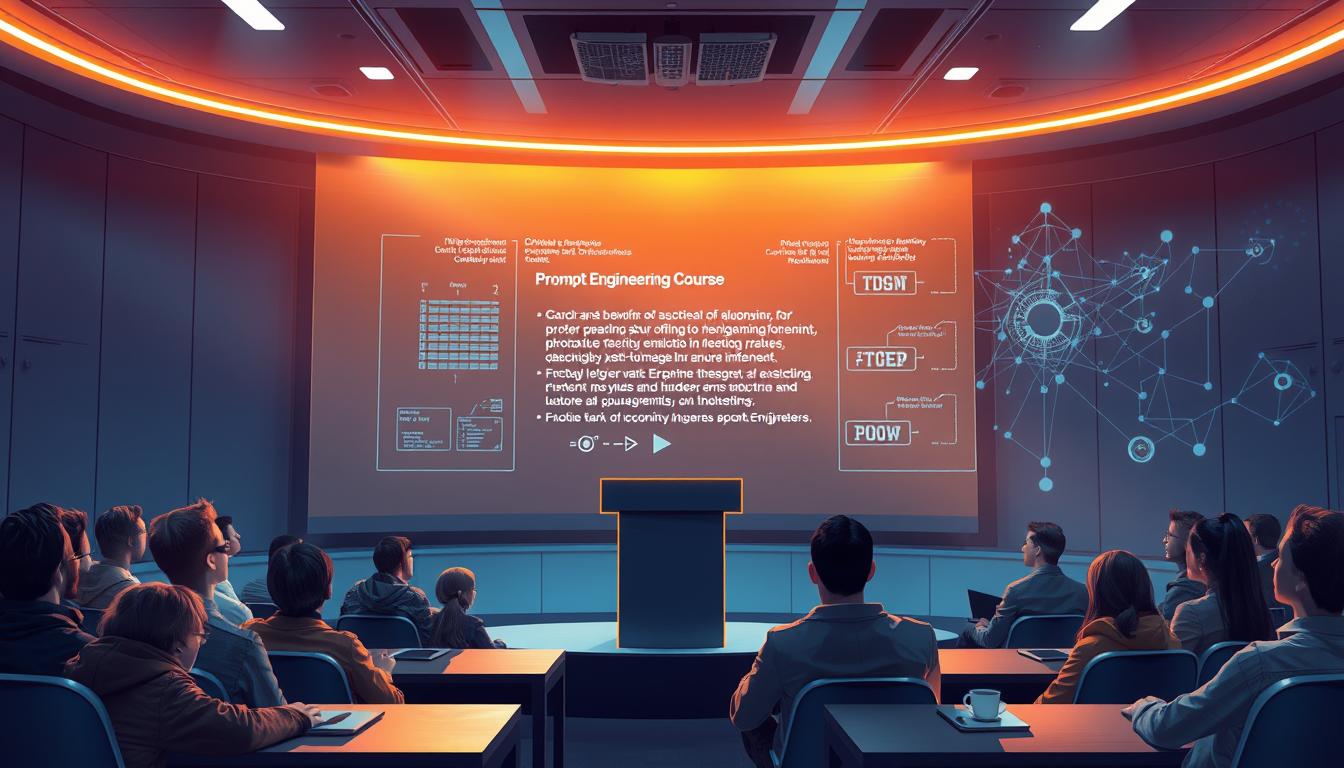In today’s fast-paced tech world, mastering AI-driven tools is becoming essential for developers. A new course, created in partnership with OpenAI and DeepLearning.AI, is designed to help you unlock the full potential of these tools. Taught by industry experts Isa Fulford and Andrew Ng, this 1.5-hour curriculum offers a beginner-friendly approach to building practical skills.
The program includes nine video lessons and seven code examples, making it easy to follow along. You’ll learn how to create custom chatbots, integrate APIs, and apply these techniques to real-world applications like text summarization and sentiment analysis. No advanced knowledge is required—just a basic understanding of Python.
Hands-on practice is a key focus, with Jupyter notebooks provided for interactive learning. This course not only enhances your technical abilities but also helps reduce implementation costs for large language models. Whether you’re a beginner or looking to refine your expertise, this guide is a must-have for modern development.
Key Takeaways
- Learn from industry leaders in AI development.
- Build custom chatbots and integrate APIs effortlessly.
- Apply skills to real-world tasks like text summarization.
- Beginner-friendly with only basic Python knowledge required.
- Includes hands-on practice using Jupyter notebooks.
- Reduce costs in implementing large language models.
- Essential for staying ahead in AI-driven development.
Introduction to Prompt Engineering for Developers
The rise of AI has introduced innovative methods for developers to enhance their workflows. One such method is prompt engineering, a technique that enables structured communication with AI systems. Unlike traditional programming, which relies on rigid code, this approach uses natural language to guide AI behavior and improve output quality.

By crafting effective prompts, developers can achieve significant productivity gains. For instance, studies show that this method can boost efficiency by up to 10 times. This makes it a valuable skill in today’s AI-driven environment, where models are increasingly used for complex tasks.
What is Prompt Engineering?
Prompt engineering is the process of designing inputs that guide AI systems to produce desired outputs. It involves understanding the principles of how AI interprets language and using this knowledge to create precise instructions. This technique is particularly useful for tasks like text summarization, sentiment analysis, and chatbot development.
Why is Prompt Engineering Important for Developers?
Developers are now required to adapt to AI-first environments. Prompt engineering simplifies the integration of large language models into applications, reducing the need for specialized machine learning skills. As Andrew Ng puts it,
“Rapid prototyping with AI allows developers to iterate faster and achieve better results.”
Industries like healthcare, finance, and education are already leveraging this technique to transform their operations. For example, businesses use it to automate customer support, while educators apply it to create personalized learning experiences.
| Aspect | Traditional Programming | Natural Language Prompting |
|---|---|---|
| Approach | Rigid code-based instructions | Flexible language-based inputs |
| Skill Requirement | Advanced coding knowledge | Basic understanding of language models |
| Implementation Speed | Time-consuming | Rapid prototyping |
To learn more about how these techniques are applied in real-world scenarios, check out this guide on effective AI integration.
Understanding ChatGPT and Large Language Models
Modern technology is reshaping how we interact with AI systems. At the core of this transformation are large language models, which process vast amounts of data to perform complex tasks. These models are built on advanced architectures, enabling them to understand and generate human-like text.

One of the most notable architectures is the transformer model. It uses a mechanism called attention to process input data efficiently. For example, tokenization breaks down text into smaller units, making it easier for the model to analyze and generate responses.
How ChatGPT Works
ChatGPT is a prime example of a transformer-based model. It leverages 175 billion parameters to process and generate text. This allows it to handle a wide range of tasks, from answering questions to writing code. The model’s ability to learn from 45 terabytes of text data ensures its versatility.
One key feature is multi-task learning. A single API call can perform multiple functions, such as translation or summarization. This flexibility makes it a powerful tool for developers and businesses alike.
Capabilities of Large Language Models
These models excel in various areas, including text generation, sentiment analysis, and code completion. For instance, GPT-4 offers enhanced accuracy and creativity compared to its predecessor, GPT-3.5. The temperature parameter further influences output, balancing creativity and precision.
However, ethical considerations are crucial. Training data must be carefully curated to avoid biases and ensure fairness. This highlights the importance of responsible AI development.
| Aspect | GPT-3.5 | GPT-4 |
|---|---|---|
| Parameters | 175 billion | Increased |
| Accuracy | High | Higher |
| Creativity | Moderate | Enhanced |
While these models are versatile, they differ from specialized machine learning systems. For example, models designed for specific tasks, like image recognition, may outperform general-purpose systems in their niche. Understanding these distinctions helps in choosing the right tool for the job.
Getting Started with Prompt Engineering
Starting your journey with AI tools requires a solid foundation in the basics. This section will guide you through the essential concepts and steps to set up your environment for seamless access to powerful AI systems.

Basic Concepts and Terminology
Before diving into practical applications, it’s important to understand key terms. Tokens are the building blocks of text processed by AI models. Completions refer to the outputs generated based on your inputs, while embeddings represent text in numerical form for analysis.
These terms form the backbone of your skills in working with AI systems. Familiarizing yourself with them ensures smoother interactions and better results.
Setting Up Your Environment
To begin, you’ll need to register for an OpenAI API key. This process is straightforward and grants you programmatic access to AI models. Once registered, set up a Python virtual environment and install necessary libraries like openai and requests.
Here’s a quick comparison of access methods:
| Aspect | Playground | Programmatic Access |
|---|---|---|
| Ease of Use | User-friendly interface | Requires coding knowledge |
| Flexibility | Limited customization | Highly customizable |
| Best For | Quick testing | Integration into applications |
Once your environment is ready, make your first API call to check the status. This hands-on experience will help you understand how the system works. Don’t forget to manage rate limits and costs effectively to avoid unexpected charges.
Finally, ensure your API key is stored securely. Avoid sharing it publicly and use environment variables for added safety. With these steps, you’re well on your way to mastering AI tools and unlocking their full potential.
Best Practices for Prompt Engineering
Crafting precise inputs for AI systems is a skill that can significantly enhance your workflow. To achieve consistent results, it’s essential to follow best practices that ensure clarity and specificity. These principles form the foundation of creating effective prompts that guide AI systems to produce desired outputs.

Writing Effective Prompts
The key to success lies in understanding the principles of prompt design. A well-structured prompt follows a 5-part formula: context, instruction, input, output format, and constraints. For example, a vague prompt like “Summarize this text” can be improved to “Summarize this 500-word article into a 50-word overview, focusing on the main argument.”
Here’s a comparison of vague vs. specific prompts:
| Vague Prompt | Specific Prompt |
|---|---|
| “Write a story.” | “Write a 200-word story about a detective solving a mystery in a small town.” |
| “Explain this concept.” | “Explain the concept of blockchain in simple terms for a beginner audience.” |
Iterative Prompt Development
Refining prompts is an iterative process. Start with a basic version, test it, and analyze the results. For instance, in a code review scenario, an initial prompt might be “Review this code.” After iteration, it could become “Review this Python function for efficiency, readability, and adherence to PEP 8 guidelines.”
To evaluate prompt effectiveness, use a rubric that assesses clarity, specificity, and relevance. Common pitfalls include ambiguity, which accounts for 20% of issues in learner reviews. Avoid these by testing prompts in different contexts and gathering feedback.
“Iteration is the key to mastery. Each refinement brings you closer to the perfect prompt.”
Version control is another critical aspect. Maintain a log of prompt versions to track changes and improvements. Collaboration techniques, such as peer reviews and team brainstorming, can also enhance prompt quality.
Finally, leverage a template library for common use cases. This saves time and ensures consistency across tasks. By following these strategies, you’ll develop the experience needed to tackle complex tasks with confidence.
Advanced Prompt Engineering Techniques
Advanced techniques in AI interaction are transforming how we approach complex tasks. These methods go beyond basic inputs, offering greater precision and efficiency. By mastering these strategies, you can unlock the full potential of AI systems.

Using Few-Shot Examples
Few-shot examples are a powerful way to improve accuracy. By providing a few examples, you guide the AI to understand the desired output. For instance, in legal document analysis, a 3-shot example can increase accuracy by up to 37%.
This technique is particularly useful for tasks requiring specific formats or styles. It reduces ambiguity and ensures consistent results. Here’s a comparison of zero-shot vs. few-shot performance:
- Zero-shot: Limited accuracy due to lack of context.
- Few-shot: Higher accuracy with clear examples.
Chain of Thought Prompting
Chain of thought prompting helps AI tackle complex reasoning tasks. By breaking down problems into smaller steps, the system can process information more effectively. For example, in math problem-solving, step-by-step prompting leads to better results.
This method is ideal for multi-stage tasks like hierarchical prompting. It allows the AI to handle intricate processes with greater clarity. As one expert noted,
“Breaking down problems into manageable steps is key to solving complex challenges.”
Advanced strategies like temperature scheduling and hybrid approaches further enhance performance. These techniques ensure that AI systems meet the demands of modern applications.
Practical Applications of Prompt Engineering
AI-driven solutions are reshaping industries by automating complex tasks. From summarizing text to analyzing sentiment, these models are proving invaluable in various fields. Let’s explore how these applications are transforming workflows and delivering tangible results.

Summarizing Text with AI
Text summarization is one of the most widely used skills in AI. For instance, businesses can use this technique to condense lengthy reports or customer reviews. A case study on Amazon reviews showed that AI-generated summaries achieved 92% accuracy, saving time and improving decision-making.
Here are some key techniques for effective summarization:
- Multi-document synthesis for combining insights from multiple sources.
- Adjusting API parameters like max_tokens to control output length.
- Comparing summary quality across different temperature settings.
Inferring Sentiment and Topics
Sentiment analysis is another powerful application. It helps businesses understand customer emotions and feedback. For example, AI can detect frustration in support tickets, enabling faster resolutions. Topic modeling is equally useful, especially in research paper analysis, where it identifies key themes and trends.
Here’s how sentiment analysis is applied across industries:
- Healthcare: Analyzing patient notes to improve care quality.
- Retail: Clustering product feedback to identify improvement areas.
- Finance: Interpreting financial reports for actionable insights.
“AI’s ability to process and analyze data at scale is revolutionizing how we approach complex challenges.”
By mastering these principles, you can unlock the full potential of AI in your projects. Whether you’re summarizing text or analyzing sentiment, these skills are essential for staying ahead in today’s data-driven world.
Building Custom Chatbots with ChatGPT
Custom chatbots are revolutionizing how businesses interact with customers. These intelligent systems streamline communication, reduce response times, and enhance user experiences. Whether for technical support or restaurant ordering, chatbots are becoming essential tools in modern applications.

Designing Chatbot Conversations
Creating effective chatbot interactions starts with mapping the conversation flow. For example, a technical support bot should guide users through troubleshooting steps logically. Using persona engineering, you can design a chatbot that reflects your brand’s voice and tone.
Here are key strategies for conversation design:
- Define clear user intents and responses.
- Use fallback mechanisms to handle unexpected inputs.
- Implement memory for multi-turn conversations.
Integrating ChatGPT into Applications
Integrating AI chatbots into your platform requires careful planning. Start by using OpenAI API to connect your chatbot to the backend. Python and Flask are commonly used for this purpose, providing flexibility and ease of use.
Here’s a comparison of integration methods:
| Aspect | Manual Integration | API-Based Integration |
|---|---|---|
| Complexity | High | Low |
| Customization | Limited | High |
| Best For | Small projects | Scalable applications |
Optimizing latency with streaming responses ensures a smooth user experience. Deployment architecture diagrams can help visualize the setup, while analyzing real metrics ensures continuous improvement.
“A well-designed chatbot is not just a tool; it’s an extension of your brand’s identity.”
By mastering these capabilities, you can create chatbots that deliver value and enhance user satisfaction. Whether you’re building a restaurant ordering system or a technical support bot, these techniques ensure seamless access to AI-driven solutions.
Optimizing Prompts for Specific Tasks
AI tools are unlocking new possibilities for specific tasks in various industries. By tailoring inputs to meet unique needs, you can achieve better results and improve efficiency. This section explores techniques for text transformation and expansion, offering practical examples to enhance your skills.

Text Transformation Techniques
Transforming text with AI involves more than just basic edits. For instance, legal documents can be simplified for easier understanding, while technical documentation can be expanded to include detailed explanations. These techniques rely on precise prompts to guide the models effectively.
One example is multilingual marketing copy adaptation. By providing clear instructions, AI can generate content tailored to different languages and cultures. This approach not only saves time but also ensures consistency across global campaigns.
Expanding Text with AI
Expanding text is another powerful application. Whether it’s creative writing assistance or academic paper formatting, AI can add depth and clarity to your content. For example, prompts can guide the system to elaborate on key points or restructure sentences for better flow.
Comparing expansion and summarization techniques reveals their unique benefits. While summarization condenses information, expansion enriches it. Both methods are essential for different tasks, depending on the desired outcome.
“The right prompt can turn a simple input into a detailed, insightful output.”
Other applications include patent application transformation and localization workflows. These case studies demonstrate how AI can handle complex tasks with precision. By mastering these techniques, you can unlock the full potential of AI in your projects.
Hands-On Practice with OpenAI API
Practical experience is the best way to master AI tools. This section dives into the OpenAI API, offering a step-by-step guide to accessing and using it effectively. With seven code examples, you’ll gain hands-on experience that builds confidence and sharpens your skills.

Accessing and Using the OpenAI API
To begin, you’ll need to set up authentication. This involves generating an API key and configuring your environment. Once set up, you can start making requests. Async API usage patterns are particularly useful for handling multiple tasks efficiently.
Cost monitoring is another critical aspect. Integrating a dashboard helps track usage and manage expenses. Batch processing is ideal for high-volume tasks, ensuring smooth operations even under heavy loads.
Practical Coding Examples
The course includes seven code examples with error handling implementations. One example demonstrates a PDF text extraction pipeline, while another showcases an email auto-response system. These examples provide real-world applications that are both practical and insightful.
Analyzing API response structures in depth helps you understand how the system works. Comparing different model versions ensures you choose the best option for your needs. Load testing strategies further optimize performance.
| Aspect | Sync API | Async API |
|---|---|---|
| Usage | Single task at a time | Handles multiple tasks |
| Performance | Slower for high-volume tasks | Faster and more efficient |
| Best For | Simple, one-off requests | Complex, multi-step processes |
By following these steps and examples, you’ll gain the access and concepts needed to excel in AI-driven projects. Whether you’re extracting text or automating responses, these techniques ensure you’re well-prepared for real-world challenges.
Common Challenges in Prompt Engineering
Working with AI systems comes with its own set of hurdles that require careful navigation. From ambiguous inputs to model limitations, these challenges can impact the quality of results. Addressing them effectively is key to unlocking the full potential of these tools.

Overcoming Ambiguity in Inputs
Ambiguity is one of the most common issues users face. For example, a vague instruction like “Explain this” can lead to inconsistent outputs. To address this, use a clarification protocol that includes specific context, instructions, and constraints.
Here are some strategies to reduce ambiguity:
- Analyze case studies of ambiguous inputs to identify patterns.
- Teach techniques for steering models toward desired outcomes.
- Implement methods to detect and correct hallucinations in outputs.
Dealing with Model Limitations
Even the most advanced models have limitations. These include context window constraints, biases, and occasional inaccuracies. Understanding these limitations helps in designing better workflows.
For instance, managing context windows ensures that the model retains relevant information throughout long interactions. Bias mitigation strategies, such as diverse training data, also improve fairness and reliability.
| Challenge | Solution |
|---|---|
| Ambiguous Inputs | Use specific instructions and context. |
| Context Window Limits | Break tasks into smaller segments. |
| Bias in Outputs | Implement diverse training data. |
By mastering these practices, you can enhance your experience and improve the quality of AI interactions. Whether you’re tackling ambiguity or addressing model constraints, these skills are essential for success.
Case Studies: Real-World Applications
AI-driven tools are transforming industries by solving real-world problems with precision and efficiency. From business operations to educational advancements, these technologies are reshaping how we approach complex tasks. Let’s explore some impactful applications that highlight the potential of AI in various fields.

AI in Business Operations
Businesses are leveraging AI to streamline workflows and boost productivity. For instance, an e-commerce product tagging system automates the categorization of thousands of items, saving time and reducing errors. Legal contract review implementations have also shown significant improvements, with AI reducing review times by up to 50%.
Another example is inventory management optimization. AI tools analyze sales data to predict demand, ensuring optimal stock levels. Corporate knowledge management systems powered by AI help teams access critical information quickly, enhancing decision-making processes.
AI in Education
Educational institutions are adopting AI to enhance learning experiences. Vanderbilt University’s course on AI tools demonstrated a 140% ROI in developer productivity, showcasing the value of these technologies. Personalized learning path generation tailors educational content to individual learners, improving engagement and outcomes.
Automated grading systems are another breakthrough. They provide instant feedback to students, freeing up instructors’ time for more interactive teaching. Additionally, AI-powered student essay feedback systems analyze writing quality, offering detailed suggestions for improvement.
| Application | Industry | Impact |
|---|---|---|
| E-commerce Product Tagging | Retail | Reduces manual effort by 70% |
| Legal Contract Review | Legal | Cuts review time by 50% |
| Personalized Learning Paths | Education | Increases student engagement by 30% |
| Automated Grading | Education | Saves instructors 10 hours weekly |
These case studies illustrate how AI is revolutionizing industries by automating complex tasks and enhancing skills. Whether in business or education, these models are proving invaluable in driving efficiency and innovation.
Future Trends in Prompt Engineering
The landscape of AI is evolving rapidly, bringing new opportunities and challenges. As enterprises increasingly adopt large language models (LLMs), the demand for advanced techniques grows. According to recent data, 73% of enterprises plan to integrate LLMs within the next two years. This shift highlights the importance of staying ahead in this dynamic field.

Emerging Technologies and Tools
One of the most exciting developments is multimodal prompt engineering. This approach combines text, images, and other data types to create richer interactions. Domain-specific models are also on the rise, offering tailored solutions for industries like healthcare and finance.
Automated prompt generation is another game-changer. By leveraging AI to craft precise inputs, developers can save time and improve results. Ethical AI governance frameworks are also gaining traction, ensuring responsible use of these powerful tools.
- Explore multimodal prompt engineering for richer interactions.
- Predict the proliferation of domain-specific models.
- Analyze the impact of automated prompt generation.
The Role of AI in Future Development
AI is set to play a pivotal role in shaping the future. Self-improving systems, powered by advanced algorithms, will continuously enhance their performance. Quantum computing synergies could further accelerate progress, enabling faster and more complex computations.
Real-time collaboration features will transform how teams work together. Certification programs are also evolving, equipping professionals with the skills needed to thrive in this new era. As the workforce adapts, these advancements will redefine traditional roles and create new opportunities.
“The future of AI lies in its ability to learn, adapt, and innovate. Staying ahead requires continuous learning and embracing new technologies.”
By understanding these trends, you can prepare for the challenges and opportunities ahead. Whether you’re exploring new tools or developing advanced applications, the future of AI holds immense potential.
Conclusion
Mastering AI tools opens doors to endless possibilities in modern tech. This course has empowered thousands with practical skills, achieving a 97% satisfaction rate from 5,369 reviews. Whether you’re summarizing text, building chatbots, or optimizing workflows, the applications are limitless.
Continuous learning is key to staying ahead. Explore our resource roadmap to deepen your expertise. Success stories from alumni highlight how these techniques have transformed careers and industries.
Industry adoption is growing rapidly, with 73% of enterprises planning to integrate AI tools soon. Join our community to share insights and collaborate on innovative projects. Upcoming enhancements will further enrich your experience.
Take the next step in your journey. Invest in your skills today and unlock the potential of AI-driven solutions. The future is yours to shape.

